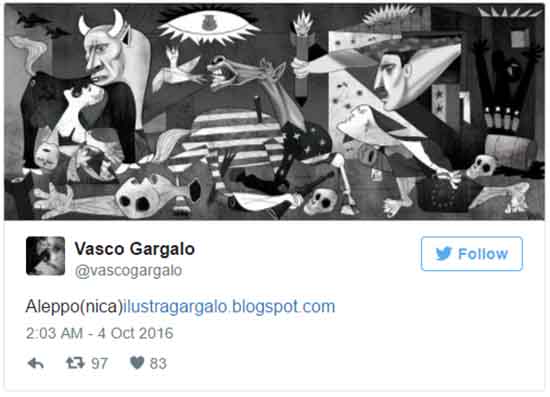Ishaan Tharoor. It was one of the first crimes against humanity to grip the global imagination. The atrocity, carried out by the German air force in league with Spain's fascist Gen. Francisco Franco, is considered the first deliberate attack on a civilian target from the air — years before Coventry, Dresden and Hiroshima, and decades before Aleppo. Guernica contained nothing of real military value. It was, and remains, a Basque cultural center and home to a sacred tree that symbolized the traditional freedoms of the Basque people — privileges Franco had little interest in defending.
To this day, the scenes of catastrophic suffering recorded in Guernica are a black mark on Spanish history.
"I was the first correspondent to reach Guernica, and was immediately pressed into service by some Basque soldiers collecting charred bodies that the flames had passed over," wrote Noel Monks of the London Daily Express. "Some of the soldiers were sobbing like children. There were flames and smoke and grit, and the smell of burning human flesh was nauseating. Houses were collapsing into the inferno."
The Manchester Guardian reported that "even flocks of sheep were machine-gunned" and that "the fires have been so extensive that many bodies will never be recovered." Estimates placed the death toll around 1,600 people, though later studies have reduced the number significantly.
"The raid on Guernica is unparalleled in military history," wrote George Steer in the Times of London two days after the bombing. "Guernica was not a military objective. A factory producing war material lay outside the town and was untouched. The object of the bombardment was seemingly the demoralization of the civil population and the destruction of the cradle of the Basque race."
Indeed, as it later emerged, the bombing of Guernica was part of a trial run for the Nazi war machine. The Condor Legion, a Luftwaffe unit created to fight alongside Franco's Nationalists, carried out the assault in coordination with Franco's troops and with support from the air force of fascist Italy. According to one historian's account, "the destruction of Guernica was planned as a belated birthday present from [Hermann] Göring to [Adolf] Hitler, orchestrated like a Wagnerian Ring of Fire."
"Guernica, city with 5,000 residents has been literally razed to the ground," wrote Wolfram von Richthofen, the Condor Legion's commander, in his diary. "Bomb craters can be seen in the streets. Simply wonderful."
Such sentiment is chilling and shocking, but it's no relic of the past. To this day, American politicians bluster with alarming glee about the prospect of carpet-bombing other parts of the world.
If Guernica's ordeal still echoes powerfully in the present, it's in large part thanks to the efforts of Spanish artist Pablo Picasso, who debuted his now-famous mural of the slaughter at an international arts exhibition in Paris in July 1937.
A "cubist apocalypse," as British art critic Jonathan Jones recently put it, the painting received mixed reviews from Picasso's initial audience. But of all the works at the exhibition — lavishly sponsored pieces of propaganda by governments including Germany's — it is Picasso's colorless tableau of grotesque forms, broken and brutalized, that is remembered to this day.
"Picasso knew exactly what he was doing when he painted Guernica," wrote Jones. "He was trying to show the truth so viscerally and permanently that it could outstare the daily lies of the age of dictators."
Both Franco's Nationalists and the Nazis initially denied any culpability in the attack, blaming it instead on retreating Republican troops. Their callousness — and the international community's mute shock — was invoked by observers last year as they watched the regime of Syrian President Bashar al-Assad and his Russian allies relentlessly bomb rebel-held areas of Aleppo.
"When it comes to incendiary weapons and munitions such as bunker buster bombs and cluster bombs, the U.N. makes it clear that the systematic use of such indiscriminate weapons in densely populated areas amounts to a war crime," said British politician Andrew Mitchell to parliament last October. "We are witnessing events that match the behavior of the Nazi regime in Guernica in Spain."
A Portuguese cartoonist updated Picasso's work to show Assad's face and that of Russian President Vladimir Putin:
The rebels have been mostly driven out of Aleppo — and so, too, hundreds of thousands of residents. It will take a long time for the devastated city to be made whole again.
It also took a while for Guernica. Franco's dictatorship suppressed Basque rights until his death in 1975. Picasso's mural, after a peripatetic life around the world, only made its way home in 1981. Eight decades on, Spain is still coming to grips with how to reckon with its bloody, divided past. In Guernica, there is now a dedicated peace museum, as well as a verdant "peace park" in the foothills surrounding the town.
And there are survivors.
Earlier this year, Luis Iriondo Aurtenetxea, who was 14 at the time of the bombing and saw Guernica burn to ash around him, spoke to the Guardian of what endures.
"We survivors will disappear. We want people to carry on our message. We want every town hall to have a peace committee to talk to their governments," he said. “When the German ambassador came here to apologize in 1997, I was asked to speak for the town. I said to him: 'A flag of peace should be raised from the ruins of what our town once was. This must never happen again.' "




 Lagun bati bidali
Lagun bati bidali Komentarioa gehitu
Komentarioa gehitu








